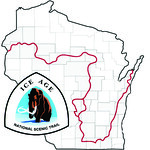A conglomerate is a rock formation made from large fragments of one type of rock held together by fine particles creating another type of rock; (eg: sandstone).
A conglomerate is always associated with high energy systems such as wave action and are generally very poorly sorted. The energy of transport must be high enough to move large grains, but is not too far from the source of sediment. There is usually significant pore space in conglomerates which act as a reservoir for ground water, natural gas, and petroleum. If the deposit is further from the source, then the sediment is more likely to be only sandstone. Prehistoric glacial deposits are a great source of conglomerate.
Conglomerate can be divided into two broad categories:
Clast supported is when the large chunks of rock (clasts) touch each other and the matrix fills the void.
Matrix supported is when the clasts are not in contact and the matrix surrounds each clast.
Conglomerate can also be found in the park near Elephant Cave and on the walls of Parfrey's Glen. At these locations, the conglomerate can be seen in layers on cliff faces. There are fragments of red Baraboo quartzite and rounded boulder within the most prominent conglomerate layer. There are also lower layers with finer more angular fragments which were not tumbled and abraided by waves as long as those in the upper layers. When extremely angular, the rock may be considered a breccias. These layers were deposited in a shallow ocean as waves pounded against the quartzite bluff.
 IATCC is the cache designation to highlight a series of EarthCaches along the Ice Age National Scenic Trail grouped into a special category called "ColdCache."
IATCC is the cache designation to highlight a series of EarthCaches along the Ice Age National Scenic Trail grouped into a special category called "ColdCache."
The Ice Age Trail is one of eleven National Scenic Trails designated by the National Park Service. This unique trail is entirely within the state of Wisconsin and follows along the terminal moraine of the most recent glacier which retreated about 10,000 years ago.
This project is supported by the Ice Age Trail Alliance (IATA). The goal is to bring more visitors to the trail and promote public awareness, appreciation, and understanding of Wisconsin’s glacial landscape.
The IATA has created an awards program to encourage visits to the trail and ColdCache sites. This awards program is separate from, and in addition to, any other Geo- or EarthCache awards program.
A current list of approved ColdCache sites can be found on the “IATCC Bookmark List”. More information on the Ice Age Trail Atlas, the Companion Guide, the ColdCache Project and Awards Program can be found on the “ColdCache Webpage”
The Geocache Notification Form has been submitted to Steve Schmelzer of the Wisconsin DNR. Geocaches placed on Wisconsin Department of Natural Resource managed lands require permission by means of a notification form. Please print out a paper copy of the notification form, fill in all required information, then submit it to the land manager. The DNR Notification form and land manager information can be obtained at: www.wi-geocaching.com/hiding
Resources:
Geology of the Ice Age National Scenic Trail; by David M. Mickelson, Louis J. Mahler Jr., and Susan L. Simpson
Mineral Gallery (www.galleries.com)
Roadside Geology of Wisconsin; by Robert H. Dott, Jr and John W. Attig
The University of Auckland, New Zealand
To claim this find:
The conglomerate at this location can be seen on the south side of the trail as you walk on the steps.
1. Is the conglomerate in layers or chunks at this location? How many layers or chunks of conglomerate do you see nearby?
2. Would you describe the conglomerate as clast supported or matrix supported?
3. Would you describe the clasts as angular or rounded? What does this tell you about the wave action when the conglomerate was formed?